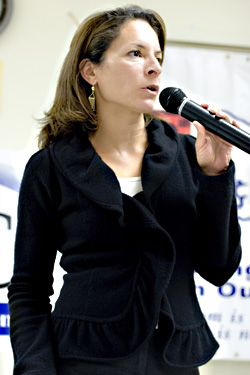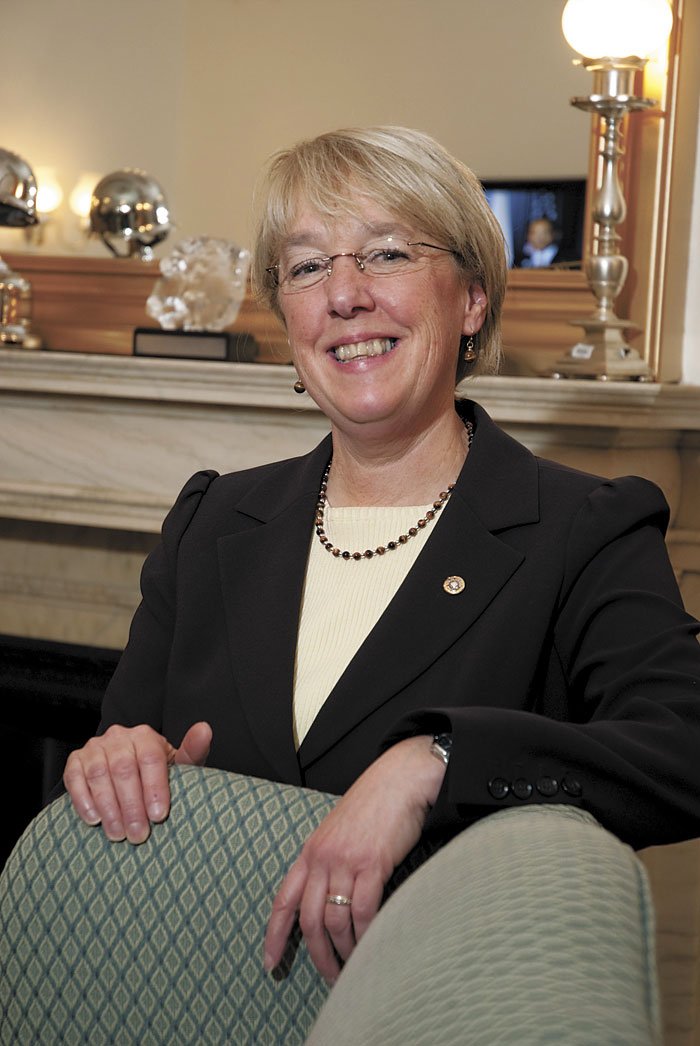This story has been corrected to reflect that Dan Evans has contributed $600 to the Velázquez campaign, not $1,100.
Bruce Harrell is eating soul food in a Central District bar, talking about his opponent in the City Council race, Venus Velázquez. “She has a remarkable ability to polarize people. Particularly around race.” Harrell, who is half-Japanese and half–African American, says he doesn’t want to be elected because of the color of his skin, but he believes his opponent is employing just that strategy.
“She describes the need for Hispanic representation on the council and uses that as a platform,” he says. “While there may be need for Hispanic or diverse representation on the council, I think what is most important is that [we] elect an effective City Council person.”
Velázquez, who is of Puerto Rican descent, dismisses Harrell’s charge. Her campaign, she says, “is about my vision for the city. I’m not going to get distracted.” Still, many of those who’ve tangled with Velázquez over the years say that playing on race—and exploiting Seattleites’ anxiety about being labeled racist—has been a frequent tactic.
Velázquez has recently been haunted by the closing statement she made in June at an immigrant community forum: “We need to bring people on City Council that are from our communities,” she said. “You need to look at this leadership up here and decide, are we the people who look like you, who come from you? And if we’re not, don’t vote for us. But if we are, vote us in.”
The comment took on new life last month after it was picked up and circulated on local blogs. It didn’t take long for Harrell to jump on it. His campaign sent out a press release in which the former chair of the Seattle NAACP and Richard McIver (Seattle’s only African American City Council member), among others, asked Velázquez for an apology.
Velázquez says that what Harrell’s doing by publicizing her comments “is the worst kind of race-baiting.” She says she wasn’t just asking people to vote for her because of the color of her skin, but was also trying to appeal to people who have other things in common with her, like children, for example. (See “Child Resistant,” p. 16, for information on Harrell’s kids.)
“Democracy is about representation,” she says, adding that Harrell is also “a person of color. What would’ve been my aim there?”
Velázquez, who was born in Brooklyn, has had her share of bruising battles as a neighborhood planner and public affairs consultant since arriving here, via St. Louis, Mo., in 1991. Often, say those left in her wake, these wars have been magnified by her tendency to divide and conquer along racial lines.
In the mid-1990s, she represented the United Indians of All Tribes Foundation in its bid to build a 148,000-square-foot People’s Lodge adjacent to the Daybreak Star Cultural Center in Discovery Park. Neighbors rallied against it. The proposal ultimately spiraled into a lawsuit when the residents and the United Indians couldn’t agree. The lawsuit was settled in 2003. The lodge was never built.
Patricia Stambor, president of Friends of Discovery Park at the time, remembers that there was a lot of “fighting and name calling. Venus made it sound like we were a bunch of racists and NIMBY-ists,” she says. “That was not the case at all. We were all sensitive to the Indians’ desire to create a cultural center there. It was just that it was massive. She implied that we were hostile to the whole thing. It was upsetting.”
Stambor later battled with Velázquez over a city plan to build a new aquarium on public Pier 62/63, something Stambor calls a stealth project and a proposal that was eventually torpedoed when private donors pulled out.
When council member Jim Compton left in 2005, before his term was up, Velázquez was one of six finalists for an appointment to the position. Stambor fired off an e-mail to council member Nick Licata in protest. Referring to the People’s Lodge and the aquarium battles, she wrote: “[Velázquez] showed little understanding of the myriad of economic and environmental issues surrounding those two controversial projects but often used the race card and the children’s card to try to intimidate and browbeat skeptics and opponents who had valid and serious questions.”
Similar charges surface in connection to Velázquez’s role as the spokesperson for Casa Latina, the nonprofit day-laborer organization, in its 2005 bid to relocate from Belltown to the then-vacant Chubby & Tubby building in Rainier Valley. “She went on the attack and called our very racially diverse community racist,” says Pat Murakami, a southeast Seattle resident and community activist.
“She tried to paint the neighborhood with the charge of racism if they didn’t accept Casa Latina at the contested site,” says Pat Donnelly, who represented the neighbors in the city-sponsored mediation. “It’s the kind of behavior we’ve grown accustomed to with Karl Rove–style politics. You’re either for us or you’re against us. There’s no middle ground. No discussion. It’s scorched-earth policy.” (Casa Latina has since made plans to move to another part of the Central District.)
As the council’s nomination process for Compton’s empty seat was wrapping up, five of the six finalists (all women of color) met as a support group of sorts called “the sisterhood.” Sally Clark, the other finalist, but not a minority, was not invited.
Clark eventually won the council’s nomination. The scuttlebutt around City Hall is that Velázquez was too much of a loose cannon, too polarizing, too risky. But this year, she has the endorsement of Peter Steinbrueck, whose vacated seat she’s running to fill, and council member Richard Conlin. She’s also recently won the support of Forward Seattle, a newly formed business PAC that has more than $100,000 to spend on her campaign.
Over a quick coffee break at Tully’s, Velázquez becomes agitated when asked about the People’s Lodge and Casa Latina and whether she’s used race strategically either during this campaign or in the past. Her answers are curt. “I didn’t do that,” she says about calling residents of Rainier Valley racist. Pressed on the People’s Lodge, she says, “It’s too hard to respond. Both situations were lengthy, with a lot of conversations. Both involved issues of race for different reasons. It’s difficult to parse out.” Velázquez says discussions about these issues are distractions.
Dan Evans, a consultant who served as the city’s mediator for both the People’s Lodge and for Casa Latina, says his reaction when he first met Velázquez was, “She’s tough. She’s trouble.”
But Evans, who’s given $600 to Velázquez’s campaign, sees her as bridging the divides in the community, not widening them. “It’s a little off-putting to some people. A little more direct and incisive than some people are comfortable with,” he says. “Especially in these racially charged situations, it’s easy for folks to be offended. I understand that some people would come away feeling bruised.”
“The hard part is that her strengths are also her weaknesses,” says Jim Diers, who was head of the Department of Neighborhoods when Velázquez worked as a project manager in the Neighborhood Planning Office. Still, he says, he’s leaning toward supporting her. “She’s committed to Seattle and to issues of social justice,” he says. “I appreciate that she’s principled.”
Seattle (which, as of 2005, was 69 percent white, 14 percent Asian, 8 percent African American, and 6 percent Latino) has long had a hard time with race, particularly because the city doesn’t deal overtly with it, says Charles Rolland, executive director of Communities and Parents for Public Schools (of which Velázquez is a board member).
“When we point out these issues, a lot of people want to use it against us,” says Rolland, who is African American. “The strategy is to put us on the defensive. I refuse to be on the defensive on that issue. If that makes people say me or Venus are divisive because we want to point out race… Maybe that’s the Seattle Nice way to say they don’t want to talk about it.”






